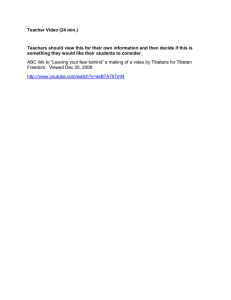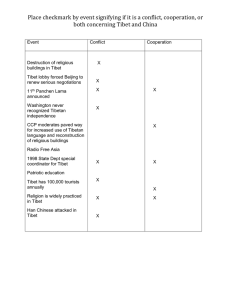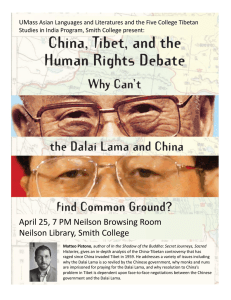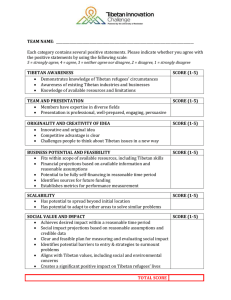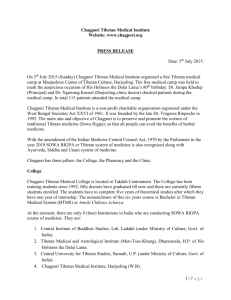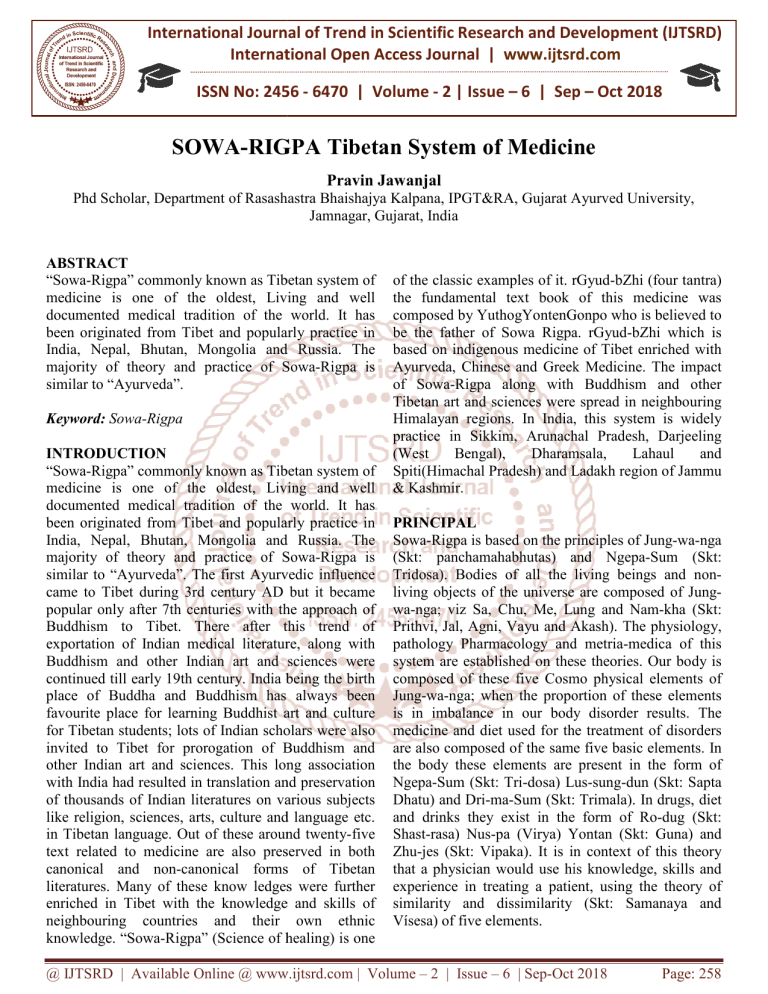
International Journal of Trend in Scientific Research and Development (IJTSRD) International Open Access Journal | www.ijtsrd.com ISSN No: 2456 - 6470 | Volume - 2 | Issue – 6 | Sep – Oct 2018 SOWA-RIGPA RIGPA Tibetan System of Medicine Pravin Jawanjal Phd Scholar, Department of Rasashastra Bhaishajya Kalpana, IPGT&RA, Gujarat Ayurved University, University Jamnagar, Gujarat, India ABSTRACT Rigpa” commonly known as Tibetan system of “Sowa-Rigpa” medicine is one of the oldest, Living and well documented medical tradition of the world. It has been originated from Tibet and popularly prac practice in India, Nepal, Bhutan, Mongolia and Russia. The majority of theory and practice of Sowa Sowa-Rigpa is similar to “Ayurveda”. Keyword: Sowa-Rigpa INTRODUCTION “Sowa-Rigpa” Rigpa” commonly known as Tibetan system of medicine is one of the oldest, Living and well documented medical tradition of the world. It has been originated from Tibet and popularly practice in India, Nepal, Bhutan, Mongolia and Russia. The majority of theory and practice of Sowa Sowa-Rigpa is similar to “Ayurveda”. The first Ayurvedic influence came to Tibet during 3rd century AD but it became popular only after 7th centuries with the approach of Buddhism to Tibet. There after this trend of exportation of Indian medical literature, along with Buddhism and other Indian art and sciences were continued till early 19th century. India being the birth place of Buddha and Buddhism has always been favourite place for learning Buddhist art and culture for Tibetan students; lots of Indian scholars were also invited to Tibet for prorogation of Buddhism and other Indian art and sciences. This long association with India had resulted in translation and preservation of thousands of Indian literatures on various subjects like religion, sciences, arts, culture and language etc. in Tibetan language. Out of these around twenty-five text related to medicine are also preserved in both canonical and non-canonical canonical forms of Tibetan literatures. Many of these know ledges were further enriched in Tibet with the knowledge and skills of neighbouring countries and their own ethnic knowledge. “Sowa-Rigpa” Rigpa” (Science of healing) is one of the classic examples of it. rGyud-bZhi rGyud (four tantra) the fundamental text book of this medicine was composed by YuthogYontenGonpo who is believed to be the father of Sowa Rigpa. rGyud-bZhi rGyud which is based on indigenous medicine of Tibet enriched with Ayurveda, Chinese and Greek Medicine. The impact of Sowa-Rigpa Rigpa along with Buddhism and other Tibetan art and sciences were spread in neighbouring Himalayan regions. In India, this system is widely practicee in Sikkim, Arunachal Pradesh, Darjeeling (West Bengal), Dharamsala, Lahaul and Spiti(Himachal Pradesh) and Ladakh region of Jammu & Kashmir. PRINCIPAL Sowa-Rigpa Rigpa is based on the principles of Jung-wa-nga Jung (Skt: panchamahabhutas) and Ngepa-Sum Ngepa (Skt: Tridosa). Bodies of all the living beings and nonnon living objects of the universe are composed of JungJung wa-nga; nga; viz Sa, Chu, Me, Lung and Nam-kha Nam (Skt: Prithvi, Jal, Agni, Vayu and Akash). The physiology, pathology thology Pharmacology and metria-medica metria of this system are established on these theories. Our body is composed of these five Cosmo physical elements of Jung-wa-nga; nga; when the proportion of these elements is in imbalance mbalance in our body disorder results. The medicine and diet used for the treatment of disorders are also composed of the same five basic elements. In the body these elements are present in the form of Ngepa-Sum (Skt: Tri-dosa) dosa) Lus-sung-dun Lus (Skt: Sapta Dhatu) and Dri-ma-Sum Sum (Skt: Trimala). In drugs, diet and drinks they exist in the form of Ro-dug Ro (Skt: Shast-rasa) Nus-pa pa (Virya) Yontan (Skt: Guna) and Zhu-jes jes (Skt: Vipaka). It is in context of this theory that a physician would use his knowledge, skills and an experience in treating a patient, using the theory of similarity and dissimilarity (Skt: Samanaya and Vísesa) of five elements. @ IJTSRD | Available Online @ www.ijtsrd.com | Volume – 2 | Issue – 6 | Sep-Oct Oct 2018 Page: 258 International Journal of Trend in Scientific Research and Development (IJTSRD) ISSN: 2456-6470 2456 The basic theory of Sowa-Rigpa Rigpa may be adumbrated in terms of the following five points: 1. The body in disease as the locus of ttreatment; 2. Antidote, i.e., the treatment; 3. The method of treatment through antidote; 4. Medicine that cures the disease; 5. Materia Medica, Pharmacy & Pharmacology PRESENT STATUS Traditionally the sMenpa are trained under the traditional educational system either under private guru-shisya shisya tradition or under gyud gyud-pa (lineage) system in families in which the knowledge is passed down from father to son through generations. It takes several years to become a skilful sMenpa, which requires hard theoretical and practicall trainings. After finishing his/her training the trainee sMenpa has to give an examination in front of the entire community in the presence of a few expert sMenpa in a ceremony to confer the designation of sMenpa on him/her. For higher training, those from m the Indian Himalayan region as well used to go to study with reputed scholars or to any of the medical colleges in Tibet in the past. Some from these regions preferred to go to Tibet to begin their education of Sowa Sowa-Rigpa. Given the modern social and educational cational system, some institutions are imparting the education at par with the modern system in terms of time with packages to be completed within a limited duration. Presently, after 10+2 grate the students are selected on entrance test merit basis. The nomenclature omenclature of this six years course is sMenpa kachupa which is equivalent to Bachelor of Sowa Rigpa (Tibetan Medicine). This course is presently conducted in following four Institutions in India: Central Institute of Buddhist Studies, Leh (under Ministry of Culture, Govt. of India) Tibetan Medical cal and Astrological Institute, DharamsalaHP HP of his Holiness Dalai Lama Central University for Tibetan Studies, Saranath UP (under Ministry of Culture, Govt. of India) Chagpori Medical Institute Darjeeling (W.B). Infrastructures of SOWA-RIGPA RIGPA IN India In most of Himalayan regions Sowa Sowa-Rigpa is practiced in traditional way with community support with an sMenpa in every village. But since the last two decades this scenario has been changing, adopting some of the administrative istrative elements of modern hospital system in educational Institutions, dispensaries, hospitals and pharmacies etc. Nevertheless, still there are all together around 1000 practitioners of Sowa-Rigpa Rigpa in India catering health care in harsh Himalayan regions region and other places. Dharamshala in Himanchal Pardesh and Ladakh region of J&K are the main Centers for Sowa-Rigpa Sowa Institutions in India. After taking refuge in India His Holiness the Dalai Lama has been in Dharamsala (Himachal Pardesh) where he has set up the Tibetan Medical and Astro. Institute to train the youngsters and provide quality health service through Sowa-Rigpa, Rigpa, This Institute has a Medical college, Pharmacy, Astrology section and a chain of 40-50 50 clinics all over India. There is Central Council for Tibetan Medicine in Dharamsala to regulate the practice of Sowa--Rigpa in India; it looks after the registration of practitioners, standard of colleges and other mechanism to regulate SowaSowa Rigpa. Ladakh Ladakh region of Jammu and Kashmir has the wide and significant presences of Sowa-Rigpa Sowa in India. There are Sowa-Rigpa Centers from both Govt. and Non Govt. Institutions, but all these Institutes are small. For education there is an Sowa Rigpa Department in Central Institute of Buddhist Studies, Leh (under er Ministry of Culture, Govt. of India) to conduct six year Kachupa course. For public heath the local administration has an OPD in district Hospital and 80 sMenpa are provided with meager financial to serve public health in remote areas. National Research Institute for Sowa-Rigpa Rigpa (under CCRAS, Ministry of Health & FW, Govt. of India), Leh has been doing R&D work on various aspects of Sowa-Rigpa. Sowa Beside these, NGO’s like Ladakh Amchi Sabha, Ladakh Society for Traditional Medicine and MentseeKhang Cultural Centre, entre, Leh etc. are working for Sowa-Rigpa Sowa in Ladakh. Himachal Pardesh In Himachal Pardesh there is sizable number of sMenpa in the region of Lahoul-Spiti, Lahoul Kinnor and Manali practicing without any support from Govt. agencies. There is a small private institute in Manali, which trains few students in Sowa-Rigpa. Sowa There is also a clinic of Men-tsee-Khang, Khang, Dharamsala. The Himachal Pardesh Govt. has also appointed sMenpa for public health in Kinnor and Lahoul-Spiti Lahoul regions. @ IJTSRD | Available Online @ www.ijtsrd.com | Volume – 2 | Issue – 6 | Sep-Oct Oct 2018 Page: 259 International Journal of Trend in Scientific Research and Development (IJTSRD) ISSN: 2456-6470 2456 Arunachal Pradesh The entire region on of Mon in Arunachal Pradesh maintains the Sowa-Rigpa Rigpa as an important part of their culture and prefers the treatment of Sowa Sowa-Rigpa to modern medicine. There was constant influx of Amchis from Tibet in the past. However these days besides some local Amchis is and a branch of Men Men-tseeKhang, Dharamsala, which was established to serve the local people in Tawang area, there is no establishment that can full fill the minimum requirement of the people. The handful of Amchis have of the take round in the various remote emote villages which has become a severe problem for the Amchis to visit them on regular basis, particularly, when the they are desperately needed, due to shortage of Amchis and lack of transportation facilities. Sikkim, Darjeeling and Kalimplong Sikkim, Darjeeling and Kalimplong also used to receive medical treatment from the visiting sMenpa from Tibet in the past, as these places were on the trade routes between Tibet and Indian cities like Calcutta. Students from these places used to go to Tibet to study Sowa-Rigpa. Rigpa. There are some sMenpa and from the local community and a branch of Men Mentsee-Khang Khang which are at great demand not only from the local people but also from the community who have come from other states of India. Despite demand from the remote areas eas of this region they can hardly visit them due to scarcity of sMenpa. In Darjeeling late Ven. Dr Trogawa-Rinpoche Rinpoche has set up a SowaSowa Rigpa medical Institute for Education and public health following the tradition of Chagpori in Tibet Other regions of India The Central University for Tibetan Studies, Saranath, Varanasi in Uttar Pradesh, which is under the Department of Culture, Ministry of Culture, Govt. of India has a faculty of Sowa-Rigpa. Rigpa. It provides a four years course of PUC and another five years and an six months course of Bachelor degree (BTMS). The faculty runs a pharmacy and OPD clinic for the training of the students. There are branches of Tibetan Medical Institute in all the Tibetan Settlements in various parts of India, which attract lots of Indians ians as well. Most of the branch -clinics clinics of Tibetan medical Institute, Dharamsala, in the cities like Delhi, Bombay and Kolkota, were opened on the request and initiatives taken by Indian people who were benefited earlier by Tibetan medicines. REFERENCES 1. http://ayush.gov.in/about-the the-systems/sowarigpa/infrastructures-sowa--rigpa-india/otherregions-india @ IJTSRD | Available Online @ www.ijtsrd.com | Volume – 2 | Issue – 6 | Sep-Oct Oct 2018 Page: 260
